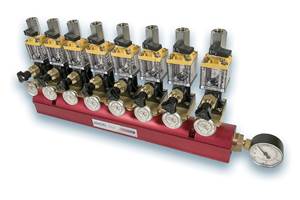New Modular Design Simplifies Temperature Control and Cuts Cost Per Loop
A brand-new physical package is said to take much of the headache and expense out of buying, installing, and maintaining temperature controls for machine barrels, thermoforming ovens, hot-runner manifolds, and a host of other plastics equipment. “No more crowded, messy, and cumbersome control panels.
A brand-new physical package is said to take much of the headache and expense out of buying, installing, and maintaining temperature controls for machine barrels, thermoforming ovens, hot-runner manifolds, and a host of other plastics equipment. “No more crowded, messy, and cumbersome control panels. No more components that lack status information. No more dealings with multiple suppliers for discrete components. No more paying for bundled components that you don’t need. Watlow’s integrated control loop just made the user’s life a whole lot simpler,” says Don Commare, product marketing manager for Watlow Electric Mfg. Co.
The firm’s new EZ-Zone ST control package with novel “integrated architecture” (patents pending) is said to be the first product to integrate temperature control, power control, safety shutdown, and power disconnect in a single package. It comprises a PID temperature controller already connected to a 40-amp solid-state relay (SSR) power switch, with the option of adding a properly sized heat sink, current measurement, over/under temperature limit control, mechanical contactor, and digital communications—all in one package. The buyer also has the option of adding a remote user interface.
A new paradigm
Until now, every temperature-control loop in a process typically required six separate components—PID controller, SSR, heat sink, current transformer, limit controller, and mechanical contactor—that had to be specified and purchased separately. (Watlow previously did not supply the current transformer or mechanical contactor.) These six components (not to mention the heater and sensor) had to be wired together and frequently required long runs of multiple wires from the control cabinet to the processing machine.
Watlow has changed all that by designing a modular system of components that snap together without wiring. This eliminates 10 to 12 wire terminations per zone (about half the usual number), saving a cost of several dollars per termination. And because all the components snap together into one compact unit—a smaller footprint than ever before, Watlow says—there is much less wiring between the control panel and the processing machine. Thus, even though the hardware components alone cost 20% to 25% more than conventional systems, Watlow is confident that its new product lowers the “total cost of ownership.”
Addressing the concept of “buy only what you need,” Watlow’s EZ-Zone ST system allows users to purchase only the number of zones they need, rather than in increments of six, 12, etc. Also, many previous single-loop controllers had the user display integrated with the PID controller, so one could not be purchased without the other. Now, for example, if a user wanted to view all zones on a remote display screen—even on the machine’s main display—there is no need to pay for displays at the control cabinet. And if one element of the system fails during use, you can replace only the affected module, not the whole system.
EZ-Zone ST is available in 1/16 DIN now and will also be offered in 1/32 DIN, 1/8 DIN, and 1/4 DIN configurations later in the year. The standard remote user interface (RUI) is a two-line, tri-colored LED display. Future models will offer enhanced LCD displays with English-language alarm messages instead of numeric codes.
Enhanced software, too
According to Commare, “Eighty percent of downtime related to temperature controls is for diagnostics, and only 20% is for replacing what’s broken.” With EZ-Zone ST, identifying the source of a problem is much easier, because all the modular components “talk to each other.” Watlow’s “Smart Power” diagnostics provide continuous self-monitoring and alarms.
PID temperature-control functions include continuous adaptive self-tuning as standard, as well as 40-step ramp and soak. A new quick-reset button on the RUI restores factory default settings. Also new is an “EZ” button on the RUI that allows users to select a preset function from a menu, such as a startup or shutdown routine.
Related Content
Cooling Bore Creates Turbulent Flow
Hasco says its Cooling Tornado facilitates turbulent flow, boosting cooling effectiveness by up to 20%.
Read MoreConair Names New Head of Customer Care
Jared Helfrich to direct the efforts of the machine builder’s growing customer care group, combining its existing parts and service and repair organization with a new range of fast-growing customer services.
Read MoreIs Your Water System Setup Helping or Hurting Your Molding Plant Productivity?
The plant water system is a critical component of an injection molding facility. A poorly designed or maintained water-cooling system can have a serious impact on production efficiency and cause many maintenance issues. Here’s what you need to know — and ask — to prevent those problems.
Read MoreKeeping Process Water Cool and Efficiency High in the Desert
Rehrig Pacific turned to Process Cooling Systems to create a high-efficiency plantwide process-cooling system for its newest injection molding facility outside of Phoenix.
Read MoreRead Next
See Recyclers Close the Loop on Trade Show Production Scrap at NPE2024
A collaboration between show organizer PLASTICS, recycler CPR and size reduction experts WEIMA and Conair recovered and recycled all production scrap at NPE2024.
Read MoreFor PLASTICS' CEO Seaholm, NPE to Shine Light on Sustainability Successes
With advocacy, communication and sustainability as three main pillars, Seaholm leads a trade association to NPE that ‘is more active today than we have ever been.’
Read MorePeople 4.0 – How to Get Buy-In from Your Staff for Industry 4.0 Systems
Implementing a production monitoring system as the foundation of a ‘smart factory’ is about integrating people with new technology as much as it is about integrating machines and computers. Here are tips from a company that has gone through the process.
Read More












